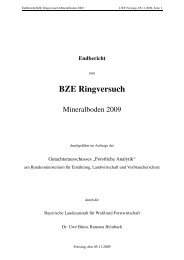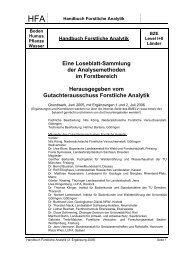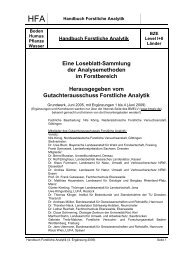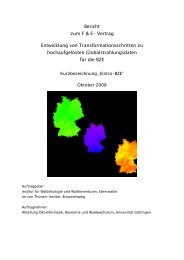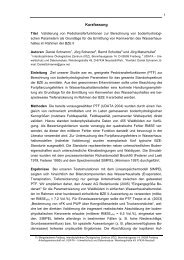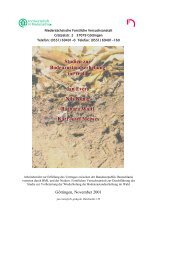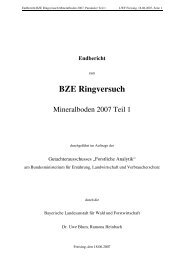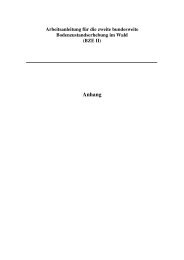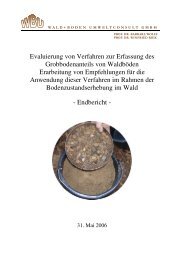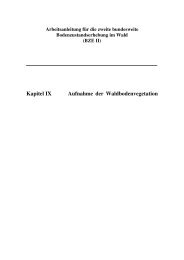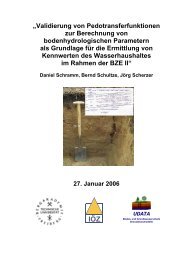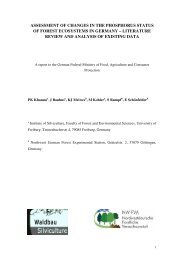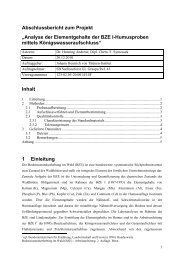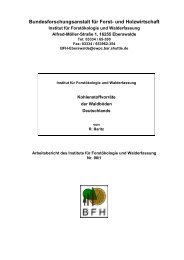assessment of changes in the phosphorus status of forest ...
assessment of changes in the phosphorus status of forest ...
assessment of changes in the phosphorus status of forest ...
You also want an ePaper? Increase the reach of your titles
YUMPU automatically turns print PDFs into web optimized ePapers that Google loves.
mostly dur<strong>in</strong>g periods <strong>of</strong> active growth, mak<strong>in</strong>g it important to chose <strong>the</strong> sampl<strong>in</strong>g<br />
period carefully for collect<strong>in</strong>g needles for nutrient <strong>assessment</strong>. There are two common<br />
hypo<strong>the</strong>ses perta<strong>in</strong><strong>in</strong>g to <strong>the</strong> fraction and amount <strong>of</strong> nutrients re-absorbed from leaves.<br />
(a) The first one considers that <strong>the</strong> amount <strong>of</strong> nutrient resorption <strong>in</strong>creases as an<br />
<strong>in</strong>verse function <strong>of</strong> soil nutrient availability (Grime 1979; Chap<strong>in</strong> 1980; Berendse<br />
& Aerts 1987). Nutrient resorption from senesc<strong>in</strong>g leaves is <strong>the</strong>refore expected to<br />
be more highly developed on sites <strong>of</strong> low fertility.<br />
(b) The second hypo<strong>the</strong>sis considers that resorption is <strong>in</strong>fluenced by s<strong>in</strong>k strength<br />
with<strong>in</strong> <strong>the</strong> plant (Nambiar & Fife 1991) so that resorption efficiency is positively<br />
correlated with plant growth rates, because <strong>the</strong> production <strong>of</strong> new tissues<br />
constitutes a strong nutrient s<strong>in</strong>k. However s<strong>in</strong>k strength is unlikely to expla<strong>in</strong> <strong>the</strong><br />
strong resorption shown by many deciduous trees <strong>in</strong> autumn where carbohydrate<br />
flux from leaves (i.e., source-s<strong>in</strong>k <strong>in</strong>teractions) may govern <strong>the</strong> retranslocation<br />
ra<strong>the</strong>r than <strong>the</strong> hydrolysis <strong>of</strong> nutrient-conta<strong>in</strong><strong>in</strong>g fractions.<br />
Interactions with o<strong>the</strong>r nutrients and <strong>the</strong> use <strong>of</strong> P/nutrient ratios<br />
Interactions among various nutrients should be considered both <strong>in</strong> <strong>the</strong> plant and <strong>in</strong> <strong>the</strong><br />
soil. It has been shown (Sterner and Elser 2002) that stoichiometry <strong>of</strong> major elements<br />
(C:N:P) may be a major ecological driver from gene to biospheres. Constancy <strong>in</strong> <strong>the</strong><br />
N:S ratios has also been reported <strong>in</strong> many ecosystem components. Of <strong>in</strong>terest for this<br />
review is <strong>the</strong> N:P ratio <strong>in</strong> <strong>the</strong> leaves, litter layer and soils. A high N/P ratio <strong>in</strong> leaves is<br />
commonly <strong>in</strong>terpreted as P limitation to plants. For litter layers, <strong>the</strong> N:P ratio above<br />
which P becomes limit<strong>in</strong>g for biological processes relative to N is considered to be<br />
16:1 (Redfield 1958) which may lead to reductions <strong>in</strong> litter decomposition rates,<br />
<strong>phosphorus</strong> release from litter, and activity <strong>of</strong> decomposer microbes. Wardle et al.<br />
(2004) used this ratio on six long-term chronosequences to report that a decl<strong>in</strong>e <strong>of</strong><br />
natural <strong>forest</strong>s, which is <strong>of</strong>ten observed <strong>in</strong> <strong>the</strong> long-term absence <strong>of</strong> catastrophic<br />
disturbance, may arise through <strong>in</strong>creas<strong>in</strong>g limitation by P and reduced performance <strong>of</strong><br />
<strong>the</strong> decomposer subsystem. Leuschner et al. (2006) studied properties <strong>of</strong> soils under<br />
50 beech stands and observed that N/P ratios <strong>in</strong> <strong>the</strong> litter layer <strong>in</strong>creased with an<br />
<strong>in</strong>crease <strong>in</strong> soil acidity which <strong>the</strong>y ascribed to <strong>the</strong> possibility <strong>of</strong> P deficiency <strong>in</strong> <strong>the</strong>se<br />
stands.<br />
27



